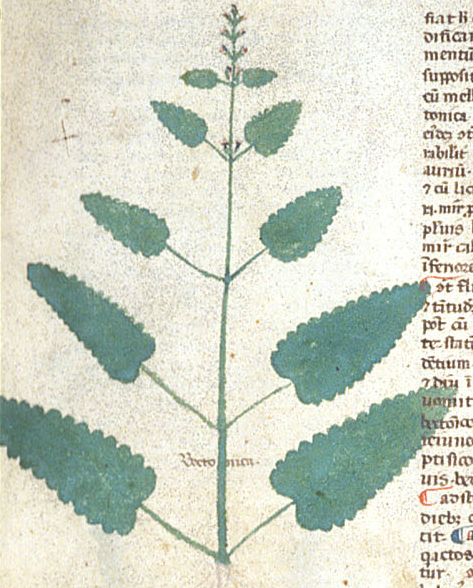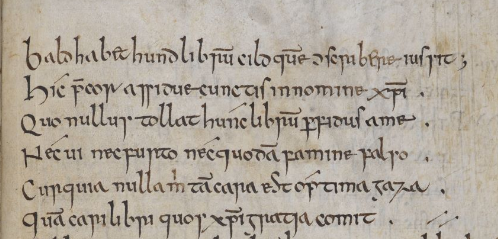I can remember exactly when it was that I discovered Anglo-Saxon medicine. For one of my undergraduate assessments in Old English, I had to write an edition, translation and commentary of an Old English text – in my case, a riddle. The speaker (I won’t ruin the riddle by giving its solution: you can find that at the bottom of the linked page if you’re curious) begins by telling how it was cruelly killed and its skin soaked and cut with a knife. I checked out the word seax, knife, in the dictionary, and that directed me to the second volume of a three-volume work with the delightful title Leechdoms, Wortcunning and Starcraft, edited in the nineteenth century by one Reverend Oswald Cockayne.

I had stumbled upon the Old English Leechbook, and, with it, the various prognostics, scientific texts and healing rites that Cockayne edited in his other two volumes.
At the time, this ended up being a source for a single footnote, but something about the Leechbook stayed in my mind, because when I came to choose a subject for my MA dissertation, I remembered that curiously-named edition, and decided to write about medicine, prognostics and the various attitudes which were taken towards them in the Anglo-Saxon church. This proved to be one of the most interesting subjects that I have worked on; and, since the completion of my PhD, I have found myself returning to the subject of medicine once again.
So why am I interested in medieval medicine and science? I suppose it is because of the complete mixture of what we now know to be correct and incorrect knowledge. Some of the remedies which were prescribed for the sick Anglo-Saxon are, to a modern audience, self-evidently ineffective; in other cases, however, it would seem that the Anglo-Saxon physician had real knowledge of the workings of herbs for healing. At the very least, their various authors and compilers clearly had expertise in identifying wild plants and a far deeper knowledge of their properties than most people nowadays do.

Practical botanical knowledge, scientific facts (and non-facts) passed down from the ancient Greeks and Romans, curiosity about the workings of the natural world, and the desire to help and heal people: these things are all to be found in medieval medical and scientific works. Furthermore, practical medicine can be linked to all sorts of different subjects: human relationships, prayer and liturgy, anatomical knowledge, and beliefs about the body and soul. There is far, far too much to write about Anglo-Saxon medicine for me to even think about confining it all to just one blogpost. So I won’t. Over the coming months, I will (I hope) write a number of posts on the medical manuscripts of Anglo-Saxon England, each taking a different slant on this deeply fascinating subject: at present, I’m planning to look at the power of plants; the power of words; the power of actions; and the knowledge of the human body; before finishing, if I haven’t covered everything, with some of my favourite remedies.
One caveat, though. A striking feature of medieval medical manuscripts, from a modern perspective, is their very diversity: religious rites for curing devil-sickness sit alongside detailed studies of the human liver; Christian prayers alongside poems which refer to the pagan gods; and herbal drinks alongside charms and curative gemstones. We can look over these books and divide them into religious and rationalistic, into pagan and Christian; but, as discussed in a previous post, that is probably not how they would have been understood by the compilers and users of the manuscripts which we actually have. They may well just have thought of all of these remedies as useful for healing. In writing the posts which will come over the next few months, therefore, I am imposing artificial distinctions upon my source material. I’m only doing it because, in a series of relatively short blogposts, it makes sense to draw attention to particular characteristics which specific medical remedies have in common. But these posts will be intended to be understood together as a set, rather than in isolation from one another.
So far, I have looked at medical texts in two major manuscripts (although many others have remedies in them, often copied into odd places in the manuscript). The first of those is, of course, the mid-tenth-century Leechbook (London, British Library Royal 12 D. xvii). The entire manuscript is made up of medical remedies, but it is divided into three parts, with an index at the start of each one. The second part is noticeably more concerned with internal illnesses, and a scientific description of the organs. Except towards the end, this part is missing the spiritual elements of healing that are commonplace in other parts of the manuscript. At the end of this second part appears a colophon explaining who put together the collection in the first place, if not necessarily for this particular manuscript:

For this reason, the first two parts are generally referred to as Bald’s Leechbook, although whether that name would be better applied just to Books I and II, or just Book II, is another question.
The other manuscript I look at is London, British Library Harley 585. This late tenth-/early eleventh-century manuscript is, again, solely devoted to medical material; the earlier part is an incomplete copy of the Old English Herbarium, a translation of two herbals dating from the fourth to sixth centuries (other manuscripts of this text exist also), followed by the Medicina de Quadrupedibus, a similar compilation of remedies based on animal parts. Both of these collections are organised according to the plant or animal in question: that is, each entry begins with a heading (e.g. ‘De betonice’, on betony), followed by a list of remedies for different illnesses that can be made using that plant or animal.
The final 63 folios of the manuscript are generally known as the Lacnunga, ‘remedies’. This section has long been a fascination of mine, ever since my MA dissertation, for the sheer variety of material inside it. Again written in Old English, Lacnunga contains a number of herbal remedies but also numerous poems (in English and Latin), incantations (in English and corrupt Irish) and religious practices, all intended to offer protection and healing.
In contrast with the Leechbook, nothing is known about who compiled Lacnunga. Unless this marginal doodle is a self-portrait, in which case it was copied by the world’s first hipster.

So, to end on, here are a few examples of the sheer variety of Anglo-Saxon remedies:
Gif þin heorte ace, nim ribban 7 wyl on meolce; drinc nygon morgenas; þe bið sona sel.
(Pettit, ed., Lacnunga, p. 72)
(‘If your heart aches, take ribbe [hound’s tongue?] and boil it in milk, and drink it for nine mornings; it will soon be well with you.’)
‘Arcus supeð assedit; uirgo canabið; lux et ure canabið.’ Sing ðis nigon siþan 7 ‘Pater noster’ VIIII on anum berenan hlafe, 7 syle þan horse etan.
(Lacnunga, ed. Pettit, p. 114)
([Mostly nonsensical Latin-ish incantation.] ‘Sing this nine times and the Lord’s Prayer nine times on a barley loaf, and give to the horse to eat.’)
Sio biþ on þa swiþran sidan aþened oþ þone neweseoþan. sio hæfð fif læppan helt þa lendenbrædan . Sio is blodes timber . 7 blodes hus .
(Cockayne, ed., Leechbook II, pp. 196, 198)
(‘It [the liver] is stretched out on the right-hand side, up to the stomach. It has five lobes and holds the loins. It is the generative material and housing of the blood.’)
Gyf hwa þas wyrte mid him hafað the we peristereon nemdon, ne mæg he fram hundum beon borcen.
(De Vriend, ed., Herbarium, p. 110)
(If someone has this plant with him, which we called peristereon [vervain?], he cannot be barked at by dogs.)
To be continued …
I’d be interested in hearing about the treatment of the mentally ill.
For example, were those with hallucinations and psychosis thought to be blessed with visions from God or inhabited by evil spirits? How were such people ‘treated’? Were the four humours relevant eg melancholy being attributed to excessive black bile?
You’ve probably got a full list of topics to cover…but if ever you did find space… Thank you.
LikeLike
Good question! Off the top of my head, I think that the various references to “devilsickness” (mostly in the *Leechbooks*, if I recall correctly) are generally interpreted as perhaps epilepsy or some kind of mental condition. A good idea for a topic all in its own right – I’ll make a note of that.
As for the four humours: there is some bloodletting, and talk about “waeta” (fluid, in this context, “humour”), generally in the more classically-influenced books like *Leechbook* II; but not, I think, a full theory of the humours in England at this time.
LikeLike